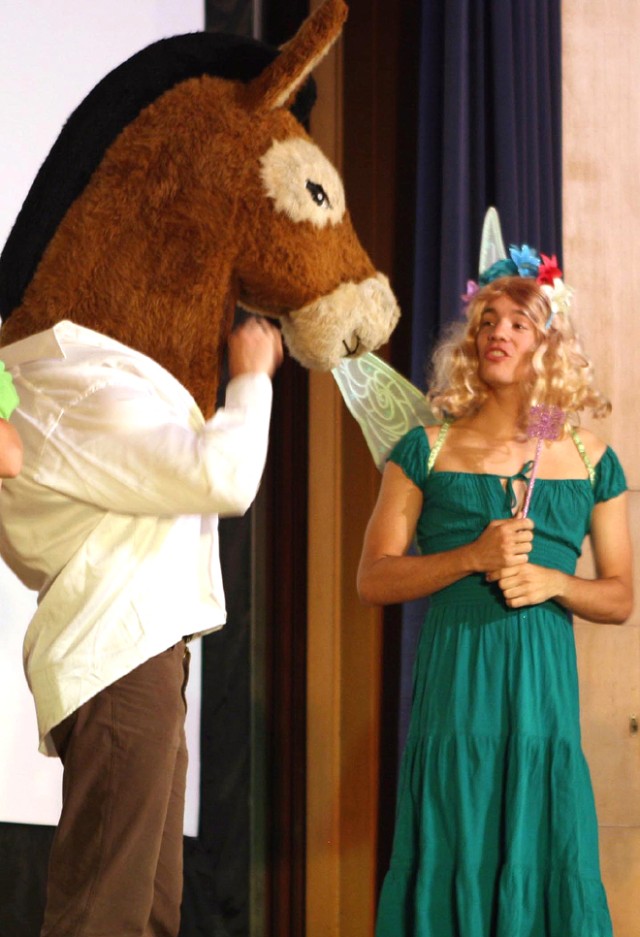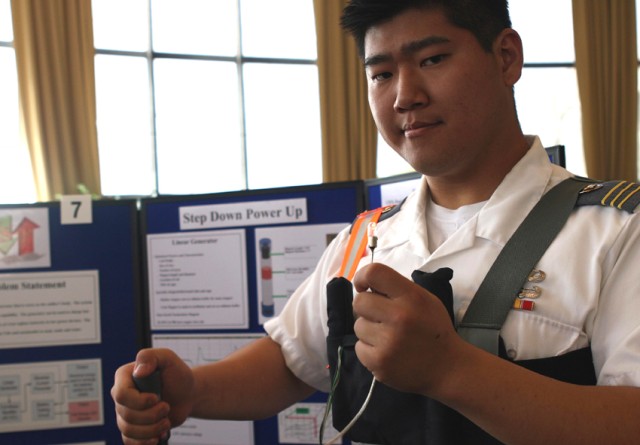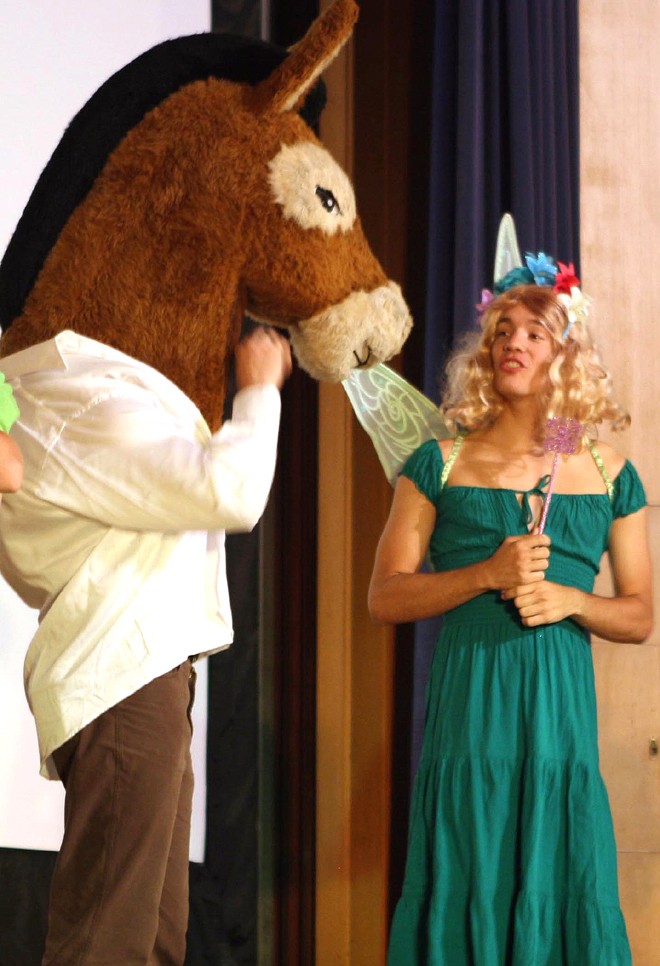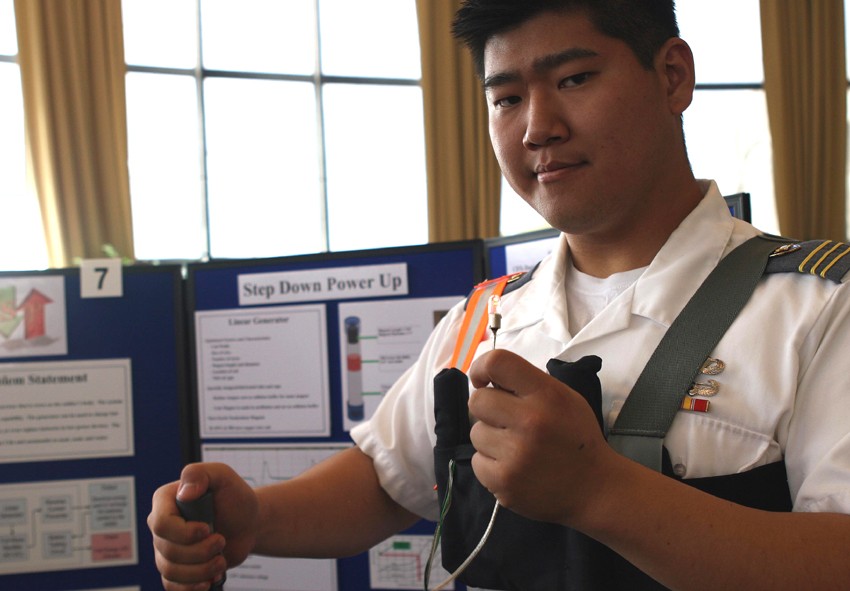It's easy for Firstie Brian Haley to list one of the most rewarding experiences in his four years at the U.S. Military Academy--Dumpster diving.
"Going on the Dumpster dive and looking through everything and seeing how things could be turned into something useful was really cool," Haley said last week when he and his teammates presented their reason for digging through trash to a room of critics and curious onlookers.
Haley and Firsties Christopher Chatellier and Yujen Lein took several journeys through junkyards to develop a functioning wind turbine made entirely out of trash for their capstone project.
All firsties presented more than 230 capstone projects and theses April 30 during USMA's annual Projects Day. Projects included everything from inventions to research papers to scientific experiments.
Cadets invented a concrete canoe, unmanned aerial vehicles, robots and a bionic foot, to name a few. They wrote theses about micro brewing, Iranian nuclear politics and control of the CIA under Presidents Eisenhower and Kennedy. They studied how to improve Army sporting events ticket processes and transportation to Stewart Airport.
When it came to making a wind turbine out of junk, Haley, Chatellier and Lein hoped to create enough energy to power a toaster oven. Their hope was to develop a machine that could provide power to third-world countries.
While the trio began with trash heaps, their plan was to recycle ordinary material found anywhere and make it something useful.
"We knew people (in third-world countries) wouldn't have junkyards to go through," Chatellier said. "So, we wanted to use common goods found in a household."
Inventing a wind turbine wouldn't be difficult--except for the fact they could not build anything unless the parts came from trash. They found aluminum sheets, aluminum tubes from air conditioning units and several motors from fans and lawn mowers. If they were using trash in a third-world country, they wouldn't expect to find aluminum, so they would use wood instead, Lein said. But for the prototype, aluminum would do.
Still, they needed something to hold everything together. They thought most third-world countries would have bicycles, so they found a couple on Craigslist. They used the bikes' frames and gears in the turbine.
The result was a working wind turbine for a grand total of $80. Unfortunately, it did not generate enough power to heat a toaster oven. Chatellier thought more time would have helped the team figure out how to generate more power.
"Maybe if we didn't have West Point and all the commitments, we would have gotten there," Chatellier said.
Several projects, such as the wind turbine, included room for cadets to pick up the projects next year and improve upon them. Firstie Jonathan Meyers' project could use a much larger data set next time, he said.
Meyers wrote software for BlackBerrys and used it to track users' movements. Every 30 seconds to a minute, the BlackBerrys would send back to Meyers' server information about where the users were including altitude, latitude and longitude.
"It's an improvement on the Facebook status," Meyers said. "We're using the simple technology people use to keep up with their friends and in different and phenomenal ways."
Instead of someone typing in Facebook or Twitter where they are and what they are doing, the BlackBerry automatically updates where the person is--provided the person remembered to carry the BlackBerry and keep it charged. Because some of Meyers' handful of test subjects didn't always have a working BlackBerry with them, he found a much larger data set--say, 100 people--would be much more effective.
Still, he was able to test a program that could potentially track terrorists, Soldiers on patrol or employees--as long as they keep the BlackBerrys on.
Meyers plans to present his invention to the International Workshop on Network Sciences in Italy and the International Conference on Information and Knowledge Engineering in Las Vegas in the coming weeks.
Just as Meyers built upon Facebook and BlackBerry technology, cadets studying English took their area's master--William Shakespeare--and added their own twists.
About 20 cadets produced the play "Seduced by Shakespeare," which was written by the Bard of Avon himself with a little help from Elizabeth Samet, USMA Dept. of English associate professor. The play featured scenes of seduction and wooing from six of Shakespeare's most beloved works--"The Taming of the Shrew," "Richard III," "A Midsummer Night's Dream," "Twelfth Night," "Macbeth" and "Henry V."
A cynical critic, played by Firstie Colin Durant, tied the scenes together. While a couple of portions were dramatic, the majority of the play featured comedic twists. "The Taming of the Shrew" took place in Atlanta and featured an overall-clad Kate who enjoyed fishing. "Twelfth Night" took place in Manhattan, and "Henry V" featured Queen Henrietta of England attempting to convince Prince Louis of France of her love at a swanky tennis club.
"A Midsummer Night's Dream" stuck a little closer to Shakespeare's original plot with the help of a beloved member of the West Point community. Tatania, played by Firstie Adam Bishop, fell in love with a forest animal. Just as in the original play, Tatania fell for Nick Bottom, whose head had been turned into that of a donkey. Bottom was portrayed by none other than USMA's own Black Jack.
While Black Jack often is a mule of few words, he did speak during the play bemoaning "what an ass" he has become.




Social Sharing